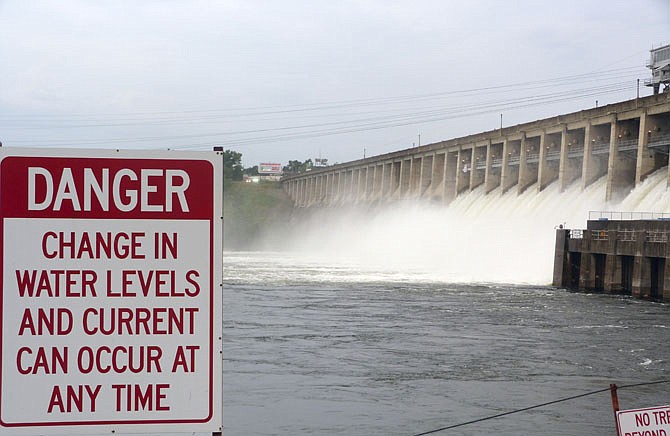LAKE OF THE OZARKS, Mo. - More than a dozen disaster agencies staged a drill last week to simulate how they would respond in the Lake of the Ozarks should Truman Dam fail upstream.
The drill is mandated by the Federal Energy Regulatory Commission (FERC), which grants Ameren Missouri a license to generate electricity at the hydroelectric plant at Bagnell Dam. The utility must stage a drill at least once every five years.
The drill, which was held at Tan-Tar-A Resort in Osage Beach, began at 8 a.m. Wednesday with representatives from federal and state agencies, county emergency management teams, several fire departments, local and statewide law enforcement, Ameren's workforce and members of the media.
Ameren engineer Alan Sullivan began the exercise by asking a representative of the National Weather Service to update the attendees on the "current" weather conditions.
The weather report stated the remnants of a Gulf of Mexico hurricane were now stalled over Central Missouri. The forecaster said some 10 inches of rain had already fallen and that at least another 10 inches were expected over the next 48 hours. The forecaster said the storm was causing rivers and streams to flood throughout the Ozarks.
At that point in the drill, the cellphones of everyone in the room rang. A recorded phone message from Ameren reported that the "torrential rainfall" was causing Truman Lake to overfill and the rapidly rising water had undermined a portion of its earth-filled dam.
In addition to creating Missouri's largest capacity reservoir, Truman Dam near Warsaw also marks the northern boundary of Lake of the Ozarks. Sitting some 92 miles above the lake's southern boundary created by Bagnell Dam, the failure of Truman Dam could wreak havoc in the rural areas and cities that lie in the floodplain around Lake of the Ozarks as well as the Osage, Missouri and Mississippi rivers.
Once the attendees had been informed that Truman Dam was being undermined and in danger of failure, they began to work together to simulate the evacuation of low-lying areas, set up shelters, call in emergency responders and generally prepare for a major disaster.
While the agencies were responding to the disaster, members of the media were encouraged to cover the event just as they would if it were actually happening.
Ameren Missouri, the Missouri State Highway Patrol and the county emergency management agencies began to "broadcast" updates to the general public and answer questions from the press.
During the next several hours, the simulated "two-day event" slowly unfolded as Ameren and the Corps of Engineers "fought to save" the earth-filled Truman Dam from eventual failure.
As part of the drill, they were unsuccessful and the dam of the reservoir, which was at more than 18 feet above capacity, failed and released billions of gallons of water into Lake of the Ozarks.
But the disaster drill didn't stop there. The group went on to simulate what would happen if Truman Lake's dam did fail.
Under the scenario, Truman's water would flow into Lake of the Ozarks, causing it to rise at a rapid rate. The large swell of water would gradually move down the main channel until it reached Bagnell Dam some 12 to 14 hours later.
The water would overtop Bagnell Dam and empty into the Osage River, causing it to rise to some 33 feet above flood stage and overflow onto nearly everything that lies in its floodplain.
All of that water would eventually reach the Missouri River at Jefferson City and continue to cause flooding all the way to St. Louis and beyond as the Missouri River emptied into the Mississippi River.
When the drill was over, each group was asked if the drill had benefited them and whether they found any problems in Ameren's handling of the disaster.
No one did; in fact, several of the agencies stated the session was so informative and so well coordinated they believed it would be beneficial if the drills became an annual event.

